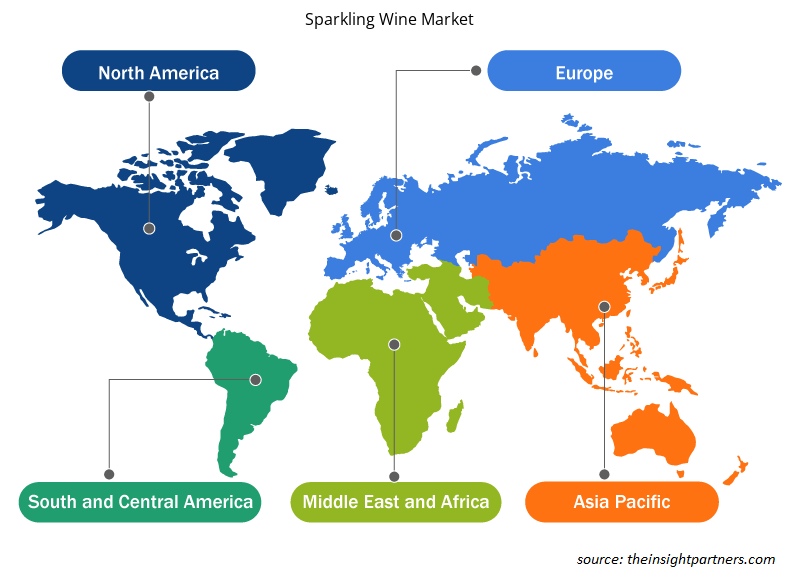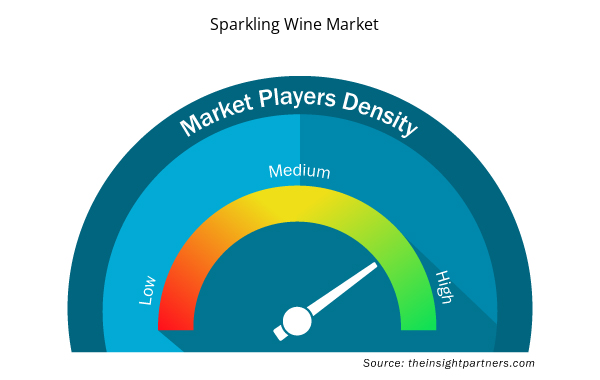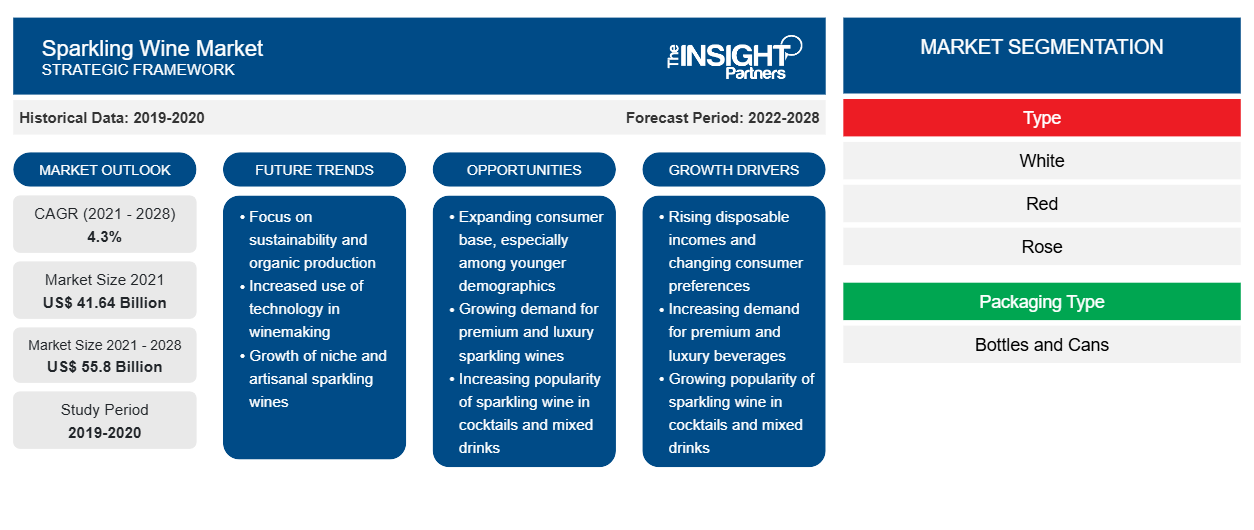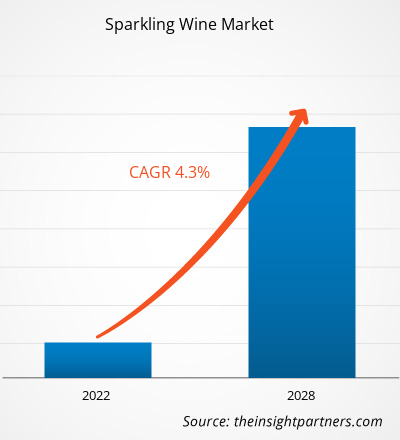Il mercato dei vini spumanti è stato valutato 41,64 miliardi di dollari nel 2021 e si prevede che raggiungerà i 55,80 miliardi di dollari entro il 2028; si prevede una crescita a un CAGR del 4,3% dal 2021 al 2028.
Lo spumante è una variante del vino con un alto contenuto di anidride carbonica, che gli conferisce ulteriore bollicina. Lo champagne è uno dei tipi di spumante più popolari. È il vino prodotto nella regione francese dello Champagne; tuttavia, molti produttori di spumante negli Stati Uniti usano questo nome per i loro prodotti locali.
Nel 2020, l'Europa ha rappresentato la quota maggiore del mercato dello spumante . L'Unione Europea (UE) ha la più grande concentrazione di produttori di spumante. Secondo l'Institute of Wine and Vine, l'UE rappresenta il 70-80% della quota, in volume, della produzione globale di spumante dal 2000. Secondo gli esperti del settore, l'Europa esporta un volume maggiore di spumante rispetto al vino fermo nei mercati internazionali. La regione ha una lunga e illustre storia di vinificazione. Gli amanti del vino in tutto il mondo preferiscono lo spumante europeo per i suoi sapori, gusti e metodi di preparazione unici. Inoltre, la crescente preferenza per bevande meno alcoliche, la crescente influenza delle celebrità sullo stile di vita delle persone, l'inclinazione verso cibi e bevande pronti e la tradizione di stappare una bottiglia di Champagne o spumante durante feste e celebrazioni, tra gli altri, giustificano il drammatico aumento della domanda per questa categoria di vino. L'Europa ha un mercato dello spumante altamente consolidato, che è composto da diversi distillatori importanti e piccoli.
I produttori di vini spumanti sono stati notevolmente colpiti dalla scarsa disponibilità di lavoratori durante la pandemia di COVID-19, che ha ostacolato la loro capacità produttiva. Inoltre, la chiusura dei mercati all'ingrosso ha costretto i produttori ad affidarsi principalmente a supermercati e rivenditori di e-commerce per vendere i loro prodotti di vini spumanti. Nonostante la pandemia, si è registrato un aumento delle vendite di vino rosato e spumante.
Personalizza questo report in base alle tue esigenze
Riceverai la personalizzazione gratuita di qualsiasi report, comprese parti di questo report, o analisi a livello nazionale, pacchetto dati Excel, oltre a usufruire di grandi offerte e sconti per start-up e università
- Scopri le principali tendenze di mercato in questo rapporto.Questo campione GRATUITO includerà analisi di dati che spaziano dalle tendenze di mercato alle stime e alle previsioni.
Approfondimenti di mercato
Aumento della popolarità del vino spumante
I rapidi cambiamenti socioeconomici e l'urbanizzazione frenetica stanno rafforzando la domanda di vino spumante. Con il continuo aumento degli standard di vita e del potere d'acquisto, i clienti desiderano acquistare articoli di lusso e di alta qualità. Inoltre, le loro abitudini alimentari e le loro preferenze per i pasti cambiano con questi cambiamenti nello stile di vita. Pertanto, la domanda di vino spumante per feste, matrimoni e incontri sociali è in aumento. Con la crescente preferenza per bevande con basso o nullo contenuto di alcol, la popolarità di questo vino sta aumentando tra i millennial, gli adolescenti e la popolazione attiva, nonché tra gli scapoli e le persone che vivono in ostelli. Inoltre, l'uso diffuso dei social media e di Internet sta influenzando in modo significativo tutte le generazioni, mentre l'aumento del numero di feste ed eventi sociali sta contribuendo all'aumento del consumo di vino spumante a livello globale, principalmente nelle nazioni sviluppate come Stati Uniti, Canada, Messico, Germania, Francia e Italia, guidando così la crescita del mercato del vino spumante.millennials, teenagers, and working populations, and in bachelors and people living in hostels. Furthermore, the widespread use of social media and the Internet is significantly impacting all generations, while rise in number of parties and social events are contributing to the rise in consumption of sparkling wine globally, primarily in developed nations such as the US, Canada, Mexico, Germany, France, and Italy, thereby driving the sparkling wine market growth.
Tipo Informazioni
In base al tipo, il mercato dei vini spumanti è suddiviso in rosso, bianco e rosato. Nel 2020, il segmento bianco ha rappresentato la quota di mercato maggiore. Il vino bianco è prodotto con uve Moscato Bianco provenienti dalla regione vinicola piemontese. La sua produzione è concentrata principalmente ad Alba e nella provincia di Asti, nel nord Italia. Le bollicine sono causate dalla fermentazione naturale, che può avvenire in bottiglia o in un grande serbatoio. La fermentazione avviene quando lo zucchero viene aggiunto al vino e il lievito agisce sullo zucchero, generando anidride carbonica. Le bollicine si formano nel vino a causa dell'anidride carbonica intrappolata all'interno di un ambiente chiuso.Moscato Bianco grapes from Italy’s Piedmont wine region. Its production is primarily concentrated in Alba and the province of Asti in Northern Italy. The bubbles are caused by natural fermentation, which might occur in the bottle or a big tank. Fermentation occurs when sugar is added to wine and yeast acts on the sugar, generating carbon dioxide. Bubbles are formed in the wine as a result of the trapped carbon dioxide inside an enclosed environment.
Bacardi & Company Limited; Bronco Wine Co.; Casella; Constellation Brands, Inc.; Henkell Freixenet; Chandon; Schramsberg Wineyards; Pernod Ricard Winemakers; The Sparkling Wine Co.; Treasury Wine Estates Ltd; Bottega Spa; Campari Group; e Codorniu sono tra i principali attori del mercato dei vini spumanti.Casella; Constellation Brands, Inc.; Henkell Freixenet; Chandon; Schramsberg Wineyards; Pernod Ricard Winemakers; The Sparkling Wine Co.; Treasury Wine Estates Ltd; Bottega Spa; Campari Group; and Codorniu are among the key players in the sparkling wine market.
Approfondimenti regionali sul mercato dei vini spumanti
Le tendenze regionali e i fattori che influenzano il mercato dei vini spumanti durante il periodo di previsione sono stati ampiamente spiegati dagli analisti di Insight Partners. Questa sezione discute anche i segmenti e la geografia del mercato dei vini spumanti in Nord America, Europa, Asia Pacifico, Medio Oriente e Africa, e Sud e Centro America.

- Ottieni i dati specifici regionali per il mercato del vino spumante
Ambito del rapporto sul mercato del vino spumante
| Attributo del report | Dettagli |
|---|---|
| Dimensioni del mercato nel 2021 | 41,64 miliardi di dollari USA |
| Dimensioni del mercato entro il 2028 | 55,8 miliardi di dollari USA |
| CAGR globale (2021 - 2028) | 4,3% |
| Dati storici | 2019-2020 |
| Periodo di previsione | 2022-2028 |
| Segmenti coperti | Per tipo
|
| Regioni e Paesi coperti | America del Nord
|
| Leader di mercato e profili aziendali chiave |
|
Densità degli attori del mercato del vino spumante: comprendere il suo impatto sulle dinamiche aziendali
Il mercato del vino spumante sta crescendo rapidamente, spinto dalla crescente domanda degli utenti finali dovuta a fattori quali l'evoluzione delle preferenze dei consumatori, i progressi tecnologici e una maggiore consapevolezza dei benefici del prodotto. Con l'aumento della domanda, le aziende stanno ampliando le loro offerte, innovando per soddisfare le esigenze dei consumatori e capitalizzando sulle tendenze emergenti, il che alimenta ulteriormente la crescita del mercato.
La densità degli operatori di mercato si riferisce alla distribuzione di aziende o società che operano in un particolare mercato o settore. Indica quanti concorrenti (operatori di mercato) sono presenti in un dato spazio di mercato in relazione alle sue dimensioni o al valore di mercato totale.
Le principali aziende che operano nel mercato dei vini spumanti sono:
- Bacardi e società a responsabilità limitata
- Azienda vinicola Bronco.
- Casella
- Marchio della costellazione, Inc.
- Henkell Freixenet
Disclaimer : le aziende elencate sopra non sono classificate secondo un ordine particolare.

- Ottieni una panoramica dei principali attori del mercato dei vini spumanti
Segnala i riflettori
- Tendenze progressive del settore nel mercato globale dello spumante per aiutare gli operatori a sviluppare strategie efficaci a lungo termine
- Strategie di crescita aziendale adottate dalle aziende nei mercati sviluppati e in via di sviluppo
- Analisi quantitativa del mercato globale dello spumante dal 2019 al 2028
- Stima della domanda di vino spumante da parte dei consumatori
- Analisi PEST per illustrare l'efficacia degli acquirenti e dei fornitori che operano nel settore per prevedere la crescita del mercato
- Sviluppi recenti per comprendere lo scenario competitivo del mercato e la domanda di vino spumante
- Tendenze e prospettive del mercato, insieme ai fattori che guidano e frenano la crescita del mercato dello spumante
- Comprensione delle strategie che sostengono l'interesse commerciale nel mercato, assistendo così nel processo decisionale per gli operatori del mercato
- Dimensioni del mercato del vino spumante nei vari nodi del mercato
- Panoramica dettagliata e segmentazione del mercato globale dello spumante, nonché delle sue dinamiche di settore
- Dimensioni del mercato del vino spumante in diverse regioni con promettenti opportunità di crescita
Mercato del vino spumante, per tipo
- Bianco
- Rosso
- Rosa
Mercato del vino spumante, per tipo di imballaggio
- Bottiglie
- Lattine
Mercato del vino spumante, per canale di distribuzione
- Supermercati e Ipermercati
- Negozi specializzati
- Vendita al dettaglio online
- Altri
Profili aziendali
- Bacardi e società a responsabilità limitata
- Azienda vinicola Bronco.
- Casella
- Marchio della costellazione, Inc.
- Henkell Freixenet
- Vigneti Schramsberg
- Produttori di vino Pernod Ricard
- La società produttrice di vini spumanti
- Azienda vinicola Treasury
- Candon-Can ...
- Analisi storica (2 anni), anno base, previsione (7 anni) con CAGR
- Analisi PEST e SWOT
- Valore/volume delle dimensioni del mercato - Globale, regionale, nazionale
- Industria e panorama competitivo
- Set di dati Excel



Report Coverage
Revenue forecast, Company Analysis, Industry landscape, Growth factors, and Trends

Segment Covered
This text is related
to segments covered.

Regional Scope
North America, Europe, Asia Pacific, Middle East & Africa, South & Central America

Country Scope
This text is related
to country scope.
Domande frequenti
Cans segment accounted for a minor share in 2020. Bottles re the most preferred type of packaging among sparkling wine consumers and manufacturers alike. However, cans can be used for single-serve and the recyclability has interested the eco-friendly consumers. Moreover, the young population that do not wish to buy an entire bottle are another target group expected to aid the growth of the cans segment over the forecast period.
Asia Pacific region accounts for a significant share of the global population and the rising disposable incomes and urbanization have contributed to the growth of the sparkling wine market in the region. The per capita consumption of wine is significantly low in the countries of Asia Pacific with respect to the western countries and this represents a significant potential for sparkling wine manufacturers. Moreover, interest in different varieties of sparkling wine from the countries such as China and India have also grown in the recent years.
Supermarkets and hypermarkets accounted for the largest share of the sparkling wine market in terms of distribution channel. The high footfall in supermarkets and hypermarkets makes it easier for sparkling wine manufacturers to target a wider customer base. The sparkling wine manufacturers mainly focus on selling sparkling wine via supermarkets and hypermarkets as they can enjoy the benefits of nationwide or area wide coverage and hence, generate a larger volume of sales.
Rose segment has been witnessing increasing popularity in recent years across the globe. Its distinct taste and color have increased its appeal among the population. Although it is a smaller category with respect to white, the segment has been registering significant growth in recent years.
The major players operating in the global sparkling wine market are Bacardi & Company Limited; Bronco Wine Co.; Casella; Constellation Brands, Inc.; Henkell Freixenet; Chandon; Schramsberg Wineyards; Pernod Ricard Winemakers; The Sparkling Wine Co.; Treasury Wine Estates Ltd; Bottega Spa; Campari Group; and Codorniu among many others.
Sparkling wines are widely consumed across the globe, especially in western countries. They are available in bottles and cans, although they are mostly purchased in bottles.
Based, on type, the sparkling wine market is segmented into white, red, and rose. Packaging type segmentation includes bottles, and cans. Based on distribution channel, the global sparkling wine market is segmented into supermarkets and hypermarkets, specialty stores, online retial, and others.
Trends and growth analysis reports related to Food and Beverages : READ MORE..
The List of Companies - Sparkling Wine Market
- Bacardi and Company Limited
- Bronco Wine Co.
- Casella
- Constellation Brands, Inc.
- Henkell Freixenet
- Schramsberg Wineyards
- Pernod Ricard Winemakers
- The Sparkling Wine Co.
- Treasury Wine Estates Ltd
- Chandon
The Insight Partners performs research in 4 major stages: Data Collection & Secondary Research, Primary Research, Data Analysis and Data Triangulation & Final Review.
- Data Collection and Secondary Research:
As a market research and consulting firm operating from a decade, we have published and advised several client across the globe. First step for any study will start with an assessment of currently available data and insights from existing reports. Further, historical and current market information is collected from Investor Presentations, Annual Reports, SEC Filings, etc., and other information related to company’s performance and market positioning are gathered from Paid Databases (Factiva, Hoovers, and Reuters) and various other publications available in public domain.
Several associations trade associates, technical forums, institutes, societies and organization are accessed to gain technical as well as market related insights through their publications such as research papers, blogs and press releases related to the studies are referred to get cues about the market. Further, white papers, journals, magazines, and other news articles published in last 3 years are scrutinized and analyzed to understand the current market trends.
- Primary Research:
The primarily interview analysis comprise of data obtained from industry participants interview and answers to survey questions gathered by in-house primary team.
For primary research, interviews are conducted with industry experts/CEOs/Marketing Managers/VPs/Subject Matter Experts from both demand and supply side to get a 360-degree view of the market. The primary team conducts several interviews based on the complexity of the markets to understand the various market trends and dynamics which makes research more credible and precise.
A typical research interview fulfils the following functions:
- Provides first-hand information on the market size, market trends, growth trends, competitive landscape, and outlook
- Validates and strengthens in-house secondary research findings
- Develops the analysis team’s expertise and market understanding
Primary research involves email interactions and telephone interviews for each market, category, segment, and sub-segment across geographies. The participants who typically take part in such a process include, but are not limited to:
- Industry participants: VPs, business development managers, market intelligence managers and national sales managers
- Outside experts: Valuation experts, research analysts and key opinion leaders specializing in the electronics and semiconductor industry.
Below is the breakup of our primary respondents by company, designation, and region:

Once we receive the confirmation from primary research sources or primary respondents, we finalize the base year market estimation and forecast the data as per the macroeconomic and microeconomic factors assessed during data collection.
- Data Analysis:
Once data is validated through both secondary as well as primary respondents, we finalize the market estimations by hypothesis formulation and factor analysis at regional and country level.
- Macro-Economic Factor Analysis:
We analyse macroeconomic indicators such the gross domestic product (GDP), increase in the demand for goods and services across industries, technological advancement, regional economic growth, governmental policies, the influence of COVID-19, PEST analysis, and other aspects. This analysis aids in setting benchmarks for various nations/regions and approximating market splits. Additionally, the general trend of the aforementioned components aid in determining the market's development possibilities.
- Country Level Data:
Various factors that are especially aligned to the country are taken into account to determine the market size for a certain area and country, including the presence of vendors, such as headquarters and offices, the country's GDP, demand patterns, and industry growth. To comprehend the market dynamics for the nation, a number of growth variables, inhibitors, application areas, and current market trends are researched. The aforementioned elements aid in determining the country's overall market's growth potential.
- Company Profile:
The “Table of Contents” is formulated by listing and analyzing more than 25 - 30 companies operating in the market ecosystem across geographies. However, we profile only 10 companies as a standard practice in our syndicate reports. These 10 companies comprise leading, emerging, and regional players. Nonetheless, our analysis is not restricted to the 10 listed companies, we also analyze other companies present in the market to develop a holistic view and understand the prevailing trends. The “Company Profiles” section in the report covers key facts, business description, products & services, financial information, SWOT analysis, and key developments. The financial information presented is extracted from the annual reports and official documents of the publicly listed companies. Upon collecting the information for the sections of respective companies, we verify them via various primary sources and then compile the data in respective company profiles. The company level information helps us in deriving the base number as well as in forecasting the market size.
- Developing Base Number:
Aggregation of sales statistics (2020-2022) and macro-economic factor, and other secondary and primary research insights are utilized to arrive at base number and related market shares for 2022. The data gaps are identified in this step and relevant market data is analyzed, collected from paid primary interviews or databases. On finalizing the base year market size, forecasts are developed on the basis of macro-economic, industry and market growth factors and company level analysis.
- Data Triangulation and Final Review:
The market findings and base year market size calculations are validated from supply as well as demand side. Demand side validations are based on macro-economic factor analysis and benchmarks for respective regions and countries. In case of supply side validations, revenues of major companies are estimated (in case not available) based on industry benchmark, approximate number of employees, product portfolio, and primary interviews revenues are gathered. Further revenue from target product/service segment is assessed to avoid overshooting of market statistics. In case of heavy deviations between supply and demand side values, all thes steps are repeated to achieve synchronization.
We follow an iterative model, wherein we share our research findings with Subject Matter Experts (SME’s) and Key Opinion Leaders (KOLs) until consensus view of the market is not formulated – this model negates any drastic deviation in the opinions of experts. Only validated and universally acceptable research findings are quoted in our reports.
We have important check points that we use to validate our research findings – which we call – data triangulation, where we validate the information, we generate from secondary sources with primary interviews and then we re-validate with our internal data bases and Subject matter experts. This comprehensive model enables us to deliver high quality, reliable data in shortest possible time.


 Ottieni un campione gratuito per questo repot
Ottieni un campione gratuito per questo repot